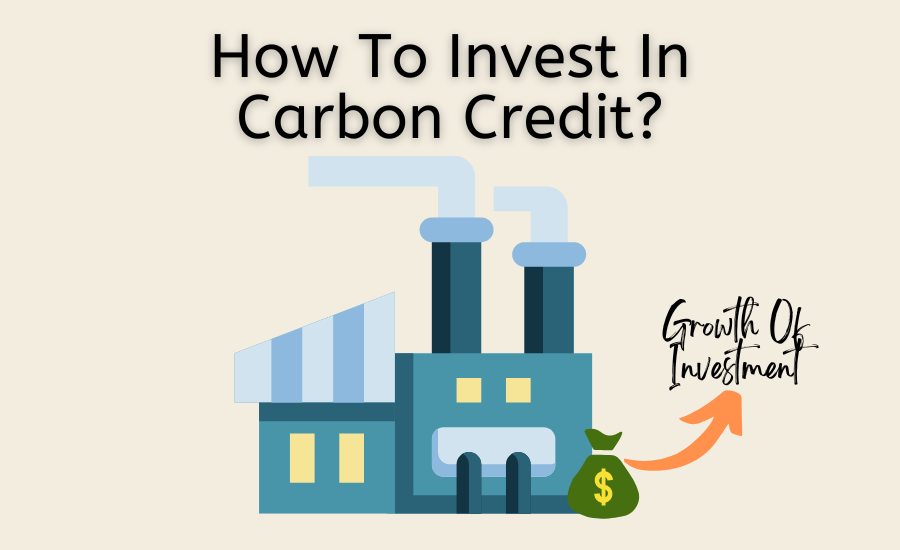How To Invest In Carbon Credit – Pros & Cons In 2023
Environmental concerns like global climate change are something you and I can’t neglect in 2022. While people all over the world are seeking ways to fight this issue, carbon credits have come to us as a boon.
They allow organizations and even individuals to reduce their greenhouse gas emissions. As a result, this initiative indirectly impacts the environment on a positive side.
The dangers of climatic change have affected the markets too, where you can invest in carbon credits. I’m certain that this is a fairly new term for most of us, carbon credits have huge potential.
So if you like the idea of investing in them, I recommend you stick around. Even if you don’t, no worries. But let me tell you that carbon credits are meant to stay for the long haul.
What are carbon credits?
To put it simply, carbon credits are permits that allow companies to emit greenhouse gas. They are effective in regulating greenhouse emissions. Generally, each credit represents one metric ton of carbon dioxide gas.
So if you have one credit, you can emit one ton of the gas. Sources like power plants that need to emit a lot of carbon dioxide need to buy permits.
On the flip side, those with extra permits can sell the carbon credits in the market. Having extra permits means that they are emitting less than the amount they are allowed.
Carbon credits save the environment by limiting organizations on their emissions. If a company doesn’t have enough carbon credits, it must immediately cut down on burning fossil fuels.
Pros and cons of investing in carbon credit
Now, the perks of investing in carbon credits are:
- Carbon credits have great potential in terms of giving you a financial return or financial security.
- They help address environmental issues which is a huge thumbs up. It is probably the best choice for environment-conscious investors.
- Carbon credits offer different investment avenues. For example, ETFs are simple to invest in. Otherwise, you can also go for futures or those of individual companies.
Also Read: How To Invest In Gold?
Carbon credits have a couple of disadvantages too.
- Since this investment is new to the market, it is tough for most of us to trust. Like every other investment, do keep in mind that carbon credits also have highs and lows.
- Generally, people tend to go for ETFs owing to the varied range they offer. However, this might not be the case for carbon credit ETFs.
- Organizations that can’t afford to reduce emissions will easily buy more credits. So, the purpose of addressing environmental concerns goes in vain.
Risks of investing in carbon credits
Carbon credits are ultimately just investments so naturally, they are not devoid of risks. ETFs in general tend to give you great industry exposure in terms of the variety of assets they track.
However, some ETFs in the case of carbon credit investments don’t allow a lot of exposure. Some are restricted to a few countries like Europe, California, etc.
Also, ETFs are not very risky. But carbon credit ETFs are responsible for tracking carbon credit futures, which are very dynamic and speculative. So you must be careful about the ETFs or futures you are choosing to invest in for carbon credits.
Also Read: Are Pokémon Cards A Good Investment?
Mediums to invest in carbon credits
Carbon credits come with some choices. Feel free to see for yourself and pick according to your preferences-
Carbon credit futures
Yes, you have futures in carbon credit investments too! A futures contract is where two parties consent to trade an asset for a particular price and on a specified date. In that case, carbon credits are the underlying assets that parties agree to trade. ETFs, which are another medium of carbon credit investment, track the carbon credit futures.
Carbon credit ETFs
If you are an individual investor, I would recommend ETFs over futures as they are simpler to understand and invest in.
For starters, let’s understand an ETF first. Exchange-traded funds are pooled investment securities that will track a bunch of underlying assets. They analyze how each asset is performing. Similarly, carbon credit ETFs will track the carbon credit market indexes.
Individual companies
Last but not the least, investing in companies that trade carbon credits is also a great way of indirect investment. If you are an individual investor, watch out for companies that give importance to their environmental responsibilities and plan to go carbon-free in the near future. You can thus enjoy the benefits indirectly.
How to start investing in carbon credit?

While you can invest in ETFs, futures, or even individual companies, I believe ETFs are the simplest for retail investors. Below is a detailed blueprint on how to systematically invest in carbon credit ETFs.
Open your account
The first step to trading in carbon credit ETFs is opening a brokerage account. If you already have one, you can operate with that otherwise go for a new one. Also, some investment apps also allow trading in ETFs.
Also Read: How To Buy OpenAI Stock – Can You Invest In ChatGPT?
Choose an ETF
This is the most crucial step as it will decide your returns in the future. ETFs are relatively new, so you won’t find too many options in the carbon credit market.
For example, KraneShares is one of the big names in this respect which you can consider.
Start trading
Now you are all set to make your first trading transaction. Open your account and find the ETF you have decided to buy. Lastly, specify the number of shares and make the purchase and that’s all!
Also Read: Can I Use RRSP For Day Trading?
Is investing in carbon credit worth it?
Carbon credits are new right now but are sure to stay in the market for a long time owing to the critical issues they solve. While they have potential, they bear a few risks too.
So, you should first analyze whether your portfolio has enough scope to bear the risks of a carbon credit investment. Also, ensure that your portfolio is diversified if you plan on investing in carbon credits.





